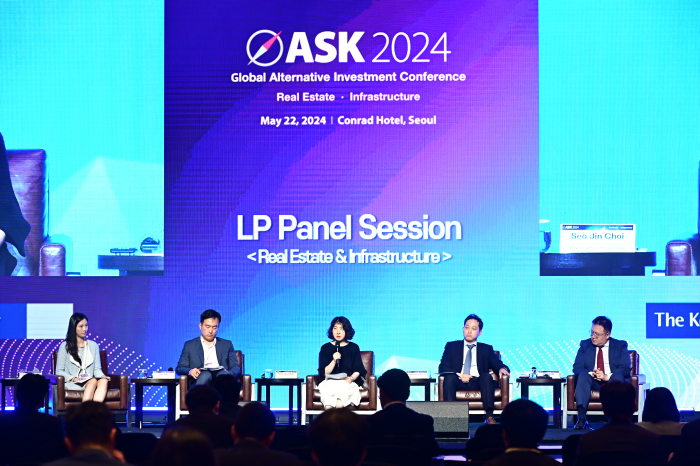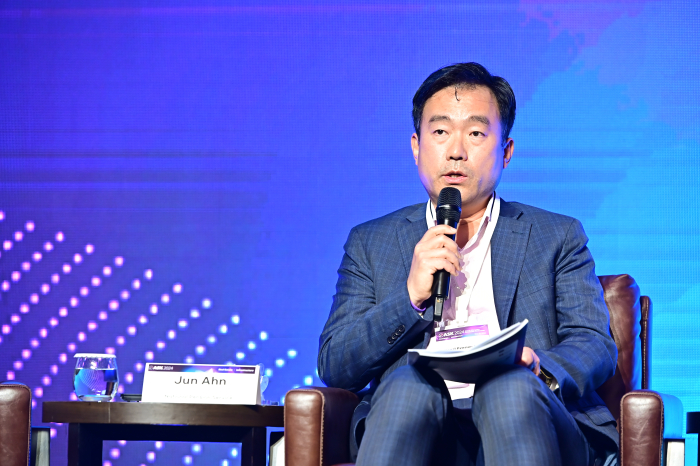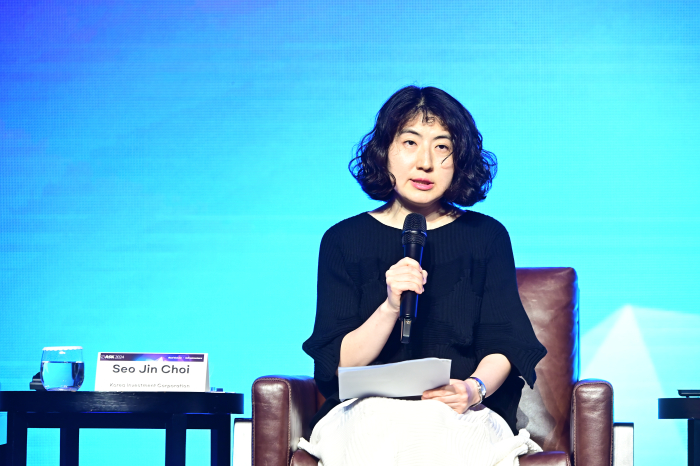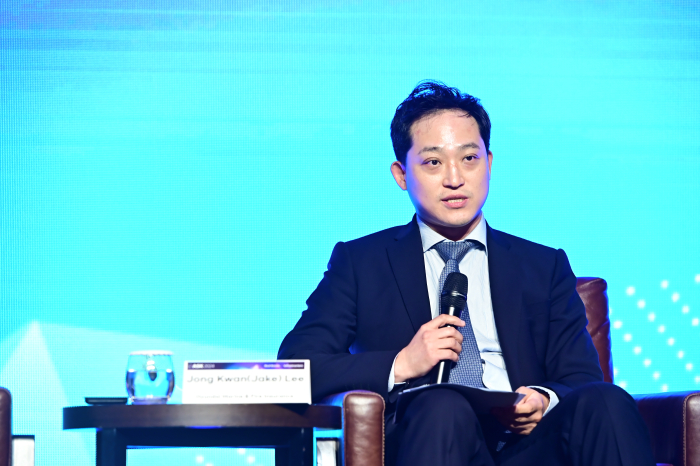Asset management
Niche real asset creates new opportunities, Korean investors say
They are closely watching mega-trends that boost real estate, digital infrastructure and renewables
By May 23, 2024 (Gmt+09:00)
6
Min read
Most Read
Samsung steps up AR race with advanced microdisplay for smart glasses


When in S. Korea, it’s a ritual: Foreigners make stops at CU, GS25, 7-Eleven


Maybe Happy Ending: A robot love story that rewrote Broadway playbook


NPS yet to schedule external manager selection; PE firms’ fundraising woes deepen


US auto parts tariffs take effect; Korea avoids heavy hit



The scope of real assets is expanding with new businesses such as infrastructure operating services and supply chain management, creating niche opportunities with flexible strategies, executives from South Korean institutional investors said at ASK 2024 on Wednesday.
South Korean limited partners (LPs) are closely watching mega-trends and demographic changes that boost real estate and will continue to invest in digital infrastructure and energy transition, the speakers at the alternative investment forum’s LP session on May 22, moderated by Savills Investment Management’s Senior Director Gabriella Aram Woo.

National Pension Service (NPS), the world’s third-largest pension fund, is paying close attention to mid-to-long-term growth sectors that have low correlation with the economic cycle, such as data centers, life science healthcare, single-family rental and self-storage, said Jun Ahn (Ahn Jun-sang), head of real estate investment division.
“We see continuous emergence of new growth sectors due to changes in demographics and lifestyle and technological advancement. I believe that it is essential to blur the boundaries between real estate and private equity to proactively respond to tenant demand within the sectors and generate new revenue streams,” Ahn explained.
The state-run fund managed 1068.5 trillion won ($784.3 billion) in assets including 171.4 trillion won for alternative investment as of end-February. Private equity, private debt and hedge funds make up 42.9% of alternative assets, and real estate and infrastructure respectively account for 30% and 26%.
In the Asia-Pacific market, NPS seeks opportunities in value add strategy targeting class-B or medium-sized offices, logistics, residential and hospitality in Japan and real estate credit investment in Australia.
The pension fund also plans to gradually expand value add and opportunistic strategies in Europe, while increasing exposure to the US’ single family rental, senior housing data center and industrial, Ahn added.
The pension scheme aims to ramp up revenue sources via its real estate platform investment team which was established early this year. The new division will focus on investing in listed real estate, general partner (GP) stakes, real estate operating firms and property tech developers to create synergy with existing real estate assets, Ahn said.

The infrastructure team of Korea Investment Corporation (KIC) will take a selective approach to re-up investment based on strategic partnerships, mid-market GPs and co-investment with downside protection during the second half of this year, said infrastructure investment head Choi Seo-jin.
The sovereign wealth fund managed $189.4 billion in assets including $42 billion for alternative investment as of end-2023. Private equity and debt, real assets and hedge funds make up around 41%, 43% and 15% of the alternative assets, respectively.
KIC, investing its entire fund in overseas assets, sees North America as the most attractive region for a mid-to-long-term infrastructure investment destination.
“We favor North America on its economic scale, expected GDP growth, geopolitical stability and government support for decarbonization and upgrading aging infrastructure such as transportation and utility. Europe is a global leader in energy transition and one of the largest infrastructure markets alongside the US, and we are carefully considering the pace of economic recovery and different regulations of each country in Europe,” Choi noted.
“We expect proactive investment in India, which has built a successful track record of private investment in renewables and toll roads, via our new office in Mumbai,” she added.
KIC is carefully considering investing in infrastructure-related business such as facility operating services and supply chain management amid intensifying competition for deal sourcing of conventional infrastructure assets, Choi said.
The fund sees data center and digital infrastructure-related services as promising, despite heightened entry valuation due to rising demand from buyers. It also sees growing opportunities in circular economy sectors, such as flexible generation and battery storage, waste treatment and renewable fuel, Choi said.

Hyundai Marine & Fire Insurance Co. will primarily focus on developed countries for stability while keeping exposure to emerging markets via blind pool funds, infrastructure team head Lee Jong-kwan (Jake Lee) said.
“For an insurer’s asset-liability management, our team highlights a bottom-up approach rather than a macro forecasting-based plan. But given the higher-for-longer rates, debt is still more attractive than equity in infrastructure investment,” said Lee.
Hyundai Marine managed 42 trillion won as of the end of 2023. The alternative investment amounted to 12.6 trillion won, of which private equity and debt, real estate and infrastructure each made up one-third.
The insurer is carefully reviewing the risk-return profile of an infrastructure deal, Lee noted.
“We are cautious of a situation where a partner suggests an infrastructure-like deal, which is private equity or real estate, for high price and low return. Such deals have risks of private equity and returns of infrastructure. Investors should think about whether the deal has an appropriate risk-return profile of infrastructure, rather than simply asking if it is an infrastructure asset.”
Distribution to paid-in capital (DPI) has become important for investors’ decision-making while internal rate of return (IRR) was a major factor in the past, Lee noted. Many LPs would need dividends for reinvestment as a new capital injection in alternative assets has been limited due to the denominator effect, he added.

ABL Life Insurance Co. has a primary focus on real estate debt in Australia given the country’s fast growth in population, immigration policies and rising demand for residential, the insurer’s alternative investment head Eoh Ji-roo said.
The insurer is also considering short-term debt in European real estate and is taking a more careful approach to US real estate debt via blind pool funds, he added.
ABL Life, a unit of China’s Dajia Insurance Group, managed 19 trillion won in assets including 4 trillion won for alternative investment as of the end of 2023. Overseas real estate and infrastructure make up around 17% and 37% of alternative assets, respectively.
The insurer is keeping an eye on digital infrastructure in the US, which has seen about a 30% annual growth of internet protocol (IP) traffic over the past 15 years and soaring demand for fiber optic cables, network and hyperscale data centers, Eoh noted.
The Australian renewable energy market is also attractive as the country aims to increase the share of renewables to 82% of the electricity, and there are growing opportunities in energy storage systems and electric vehicle charging as well as solar and wind farms, he said. The insurer will not invest in renewables highly dependent on institutional support to mitigate risks, he added.
Write to Jihyun Kim at snowy@hankyung.com
Jennifer Nicholson-Breen edited this article.
More to Read
-
 Pension fundsNPS to spur buyout, VC in US tech sector: chairman
Pension fundsNPS to spur buyout, VC in US tech sector: chairmanMay 21, 2024 (Gmt+09:00)
1 Min read -
 Asset managementKorean investors turn to private credit, secondaries: CIOs
Asset managementKorean investors turn to private credit, secondaries: CIOsMay 22, 2024 (Gmt+09:00)
3 Min read -
 Pension fundsPOBA favors data centers, senior housing in Europe: CIO
Pension fundsPOBA favors data centers, senior housing in Europe: CIOMay 22, 2024 (Gmt+09:00)
2 Min read -
 Sovereign wealth fundsKIC eyes direct lending with high return potential: CEO
Sovereign wealth fundsKIC eyes direct lending with high return potential: CEOMay 21, 2024 (Gmt+09:00)
1 Min read
Comment 0
LOG IN


